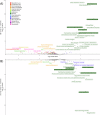Distinguishing clinical and genetic risk factors for suicidal ideation and behavior in a diverse hospital population
- PMID: 39979244
- PMCID: PMC11842747
- DOI: 10.1038/s41398-025-03287-6
Distinguishing clinical and genetic risk factors for suicidal ideation and behavior in a diverse hospital population
Abstract
Suicidal ideation (SI) and behavior (SB) are major public health concerns, but risk factors for their development and progression are poorly understood. We used ICD codes and a natural language processing algorithm to identify individuals in a hospital biobank with SI-only, SB, and controls without either. We compared the profiles of SB and SI-only patients to controls, and each other, using phenome-wide association studies (PheWAS) and polygenic risk scores (PRS). PheWAS identified many risk factors for SB and SI-only, plus specific psychiatric disorders which may be involved in progression from SI-only to SB. PRS for suicide attempt were only associated with SB, and even after accounting for psychiatric disorder PRS. SI PRS were only associated with SI-only, although not after accounting for psychiatric disorder PRS. These findings advance understanding of distinct genetic and clinical risk factors for SB and SI-only, which will aid in early detection and intervention efforts.
© 2025. The Author(s).
Conflict of interest statement
Competing interests: Dr. Mann receives royalties for commercial use of the C-SSRS from the Research Foundation for Mental Hygiene and from Columbia University for the Columbia Pathways App. The other authors have no conflicts of interest to declare. Ethics approval and consent to participate: All methods were performed in accordance with the relevant guidelines and regulations. Relevant study activities for the current report were approved by the Icahn School of Medicine at Mount Sinai Institutional Review Board (Institutional Review Board 07 0529) and all study participants provided written informed consent.
Figures


References
-
- Centers for Disease Control and Prevention. Facts About Suicide. Available from: https://www.cdc.gov/suicide/facts. Accessed March 2024.
-
- Franklin JC, Ribeiro JD, Fox KR, Bentley KH, Kleiman EM, Huang X, et al. Risk factors for suicidal thoughts and behaviors: a meta-analysis of 50 years of research. Psychol Bull. 2017;143:187–232. - PubMed
-
- Beautrais AL. Further suicidal behavior among medically serious suicide attempters. Suicide Life Threat Behav. 2004;34:1–11. - PubMed
-
- Suokas J, Suominen K, Isometsä E, Ostamo A, Lönnqvist J. Long-term risk factors for suicide mortality after attempted suicide–findings of a 14-year follow-up study. Acta Psychiatr Scand. 2001;104:117–21. - PubMed
MeSH terms
Grants and funding
- 1842169/National Science Foundation (NSF)
- 29551/Brain and Behavior Research Foundation (Brain & Behavior Research Foundation)
- R01MH123489/U.S. Department of Health & Human Services | NIH | National Institute of Mental Health (NIMH)
- S10 OD026880/OD/NIH HHS/United States
- R01 MH123489/MH/NIMH NIH HHS/United States
LinkOut - more resources
Full Text Sources
Medical

